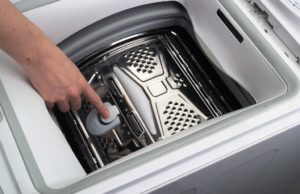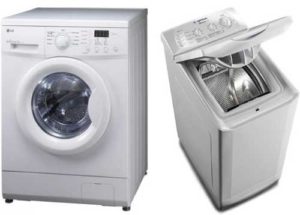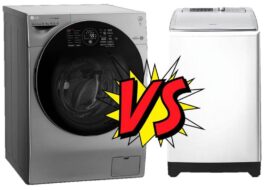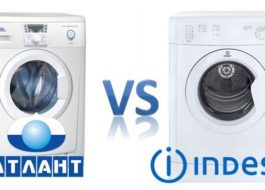Top-loading or front-loading washing machine – which is better?
 As you know, all washing machines are divided into two large groups: front-loading equipment and top-loading equipment. The difference between a horizontal washer and a vertical one is quite significant; moreover, they are not even similar in appearance. In this publication, we will compare two types of washing machines in detail and answer the long-standing question of consumers about which “home assistants” are better.
As you know, all washing machines are divided into two large groups: front-loading equipment and top-loading equipment. The difference between a horizontal washer and a vertical one is quite significant; moreover, they are not even similar in appearance. In this publication, we will compare two types of washing machines in detail and answer the long-standing question of consumers about which “home assistants” are better.
How do these washers work?
The fundamental difference between a top-loading washing machine and a front-loading washing machine is the location of the loading hatch, hence the names. For front-facing washing machines, the hatch is located on the front wall of the washing machine, and for vertical washing machines, the hatch is located on top. This difference is the main one, but not the only one.
A front-loading washing machine, like a top-loading washing machine, has drums that rotate in a vertical plane. But if in order to get to the drum of front-facing cameras you just need to open the hatch, then to access the drum of a machine with vertical loading, you need to open the hatch and special metal doors. If the drum of a top-loading washing machine does not position itself automatically, then you still need to manually tighten it, then open the doors and then just load the laundry. Besides.
- A top-loading washing machine, like a front-loading machine, has a panel
 management. The panels are generally similar, but they are located in different places: for front-facing ones, above the hatch, and for vertical ones, on top.
management. The panels are generally similar, but they are located in different places: for front-facing ones, above the hatch, and for vertical ones, on top. - A front-loading washing machine has a larger drum capacity. If for vertical washing machines the maximum load is rarely more than 6-7 kg, then for front washing machines the drum holds 12-15 kg of dirty laundry.
- Verticals have less load on the drive mechanism, which means it lasts longer. The same bearings are destroyed much less frequently, and the machine itself is much more resistant to the negative effects of centrifugal force.
- Vertical washing machines have shock absorbers and counterweights arranged differently, not that this makes a top-loading washing machine more stable, but the structural difference is obvious.
- Thanks to the location of the hatch, top-loading washing machines do not have problems stopping the wash at any time. Even the oldest models can be stopped and added laundry. Front-loading washing machines can only be stopped in cases where the manufacturer has provided this option.
- A fairly large number of different functions are integrated into front-loading washing machines: drying, bubble washing, steam washing, etc. The newest vertical ovens also have some of these functions, but they do not have drying, at least in those models that are sold in Russia.
A front-loading washing machine has a cuff - a rubber seal that prevents water from seeping through the closed hatch. In addition, there are a bunch of minor technical differences, which we will definitely tell you about when necessary.
How much space does it take?
 Many users are very interested in saving space, so they are often willing to pay extra for more compact equipment. In this sense, a front-loading washing machine is better because it is produced in as many as 4 sizes. There are washing machines: narrow, super-narrow, standard and compact. Choices can be made in almost all situations.
Many users are very interested in saving space, so they are often willing to pay extra for more compact equipment. In this sense, a front-loading washing machine is better because it is produced in as many as 4 sizes. There are washing machines: narrow, super-narrow, standard and compact. Choices can be made in almost all situations.
Top-loading washing machines are almost all the same. If all models of washing machines of this type are placed next to each other, then you will see practically no difference, although there may be slight differences in size. For example, the variation in height reaches 10 cm (from 80 to 90), although height does not play a special role here. The spread in depth is even less than 5-7 cm, but the width is often standard - 40 cm.
If we compare a standard-sized front-facing dishwasher and a vertical-size washing machine, a top-loading washing machine will take up less space. If we compare a compact front-facing camera with a vertical camera, then the first one wins a good 10 centimeters in depth and several centimeters in width. Among front-loading washing machines there are some quite unusual ones. wall models. They are apparently specially made for people who want to solve the issue of saving space radically.
When we talk about the overall dimensions of the two types of washing machines, in almost all cases front-loading washing machines win - they are better in this component.
Convenience issues
 Now let's look at the issue of convenience. Which of the two types of washing machines is more convenient for the user? When answering this question, one cannot ignore subjective factors. Often, a person simply likes a top-loading washing machine better because he is used to it, and he himself cannot really explain why. It's the same with washing machines that have front loading.We will deliberately not discuss subjective aspects, but will look directly at the objective circumstances that make this or that type of washing machine more convenient.
Now let's look at the issue of convenience. Which of the two types of washing machines is more convenient for the user? When answering this question, one cannot ignore subjective factors. Often, a person simply likes a top-loading washing machine better because he is used to it, and he himself cannot really explain why. It's the same with washing machines that have front loading.We will deliberately not discuss subjective aspects, but will look directly at the objective circumstances that make this or that type of washing machine more convenient.
- For top-loading washing machines, the hatch is located on top, which means you don’t have to bend over every time you need to load laundry into the drum. For people suffering from radiculitis, this is a very valuable design feature.
- Front-loading washing machines have a completely free top cover. Users place jars, bottles, bags of powder and other things on it as a shelf, considering it convenient.
- The front panel can be built under the tabletop, which is very convenient. The vertical one loses in this regard.
- In washing machines with front loading, the powder cuvette is easily removed, however, it is also easier to use, it is easier to pour in powder and pour in conditioner. Although experienced users of vertical machines claim that their “home assistants” have convenient powder receptacles, they are in the minority here.
Beauty and maintainability
 It is difficult to talk about the beauty of a washing machine, since each user evaluates the beauty of equipment in his own way. But there are quite objective points. Top-loading washing machines are very similar to each other; there are no differences in design. The control panel, designed to individualize the washing machine model, is located on top, and therefore does not attract attention.
It is difficult to talk about the beauty of a washing machine, since each user evaluates the beauty of equipment in his own way. But there are quite objective points. Top-loading washing machines are very similar to each other; there are no differences in design. The control panel, designed to individualize the washing machine model, is located on top, and therefore does not attract attention.
For front-facing cameras, everything is different. The size and shape of the hatch, the shape and design of the powder cuvette and control panel elements give a particular model of washing machine a unique personality and special beauty. Conduct your own experiment.Go to a hypermarket that sells household appliances and look at the range of front-loading washing machines. In this case, your gaze will definitely be drawn to the appearance of any model.
If you look in the same way at the model range of top-loading washing machines, then you will not be able to see anything remarkable - washing machines are just washing machines. There is another important nuance. If you buy a top-loading washing machine, then for the next ten years you will have to admire its appearance, since nothing can be done about it. The front camera can be installed separately, and if you get tired of its appearance, the problem can be solved by integrating the equipment into the furniture.
Only the color of the body can personalize a top-loading washing machine. The front panel is individualized by a number of elements. Which washer is better for this component? Draw your own conclusions.
As for maintainability, preference can also be given to front-loading washing machines. Everything is explained simply. There are more front-loading washing machines, and more spare parts and various components are supplied for them.
Craftsmen working in various cities of our vast homeland are better familiar with front-loading washing machines. Accordingly, components and spare parts for front-facing cameras can be purchased cheaper, and craftsmen will be relatively better able to repair them, although everything is individual. In terms of reliability, front-loading and top-loading washing machines are approximately the same; much will depend on the country of assembly, manufacturer and many other factors.
Why is vertical a little more expensive?
 According to the manufacturer himself, top-loading washing machines are a little more expensive to manufacture, which means this certainly affects the final cost of this type of home assistant. But we think this is not the only reason. The fact is that top-loading washing machines are less in demand, there are fewer of them, which means there is less demand for them. Demand, as we know, creates supply, and the more manufacturers offer front-loading washing machines, the tougher the competition between them.
According to the manufacturer himself, top-loading washing machines are a little more expensive to manufacture, which means this certainly affects the final cost of this type of home assistant. But we think this is not the only reason. The fact is that top-loading washing machines are less in demand, there are fewer of them, which means there is less demand for them. Demand, as we know, creates supply, and the more manufacturers offer front-loading washing machines, the tougher the competition between them.
Where does this lead? And this leads to the fact that producers, competing with each other, are forced to reduce prices for goods in order to stay in the corresponding economic niche. In some places this effect is more pronounced, in others less, but in the end, front-loading and vertical-loading washing machines with approximately the same technical characteristics cost differently. Moreover, the price difference is definitely not in favor of verticals.
What is the conclusion?
Based on the totality of positive features and based on the opinions of the majority of consumers, we make Conclusion - front-loading washing machines are slightly better than top-loading washing machines. Although, of course, verticals also have a right to exist; moreover, in a number of cases their use is more justified.
In principle, our general opinion is quite consistent with the market situation. If we look at the market for automatic washing machines, we see the following picture: front-loading washing machines account for about 80%, while vertical washing machines account for only about 20%. Further reasoning is pointless, because the numbers speak more eloquently.
Interesting:
Reader comments
- Share your opinion - leave a comment





















Add a comment